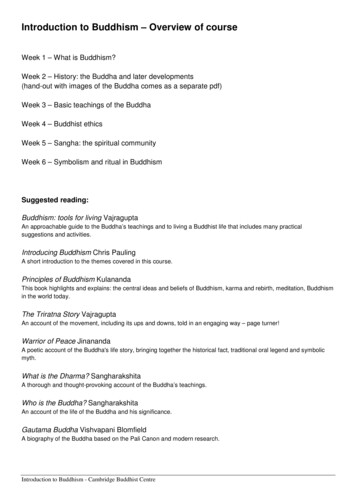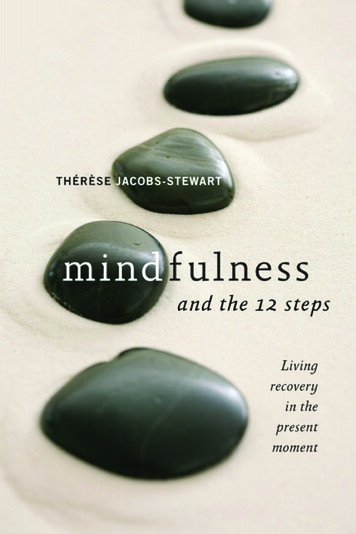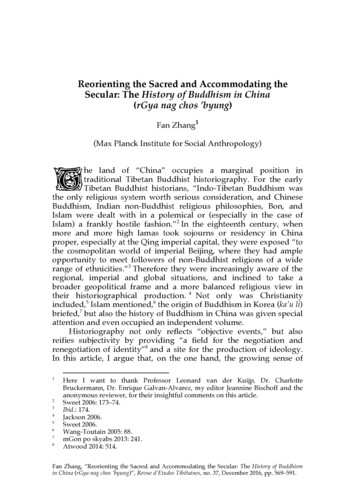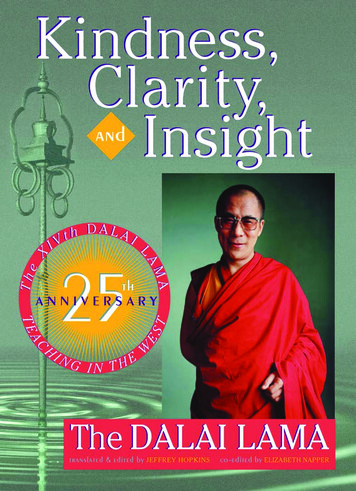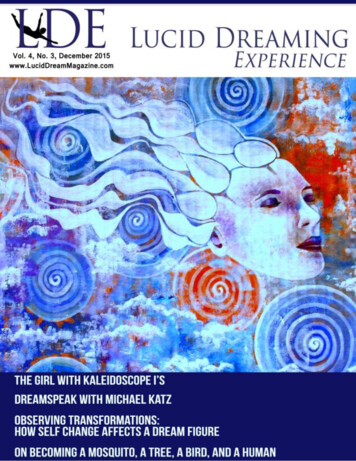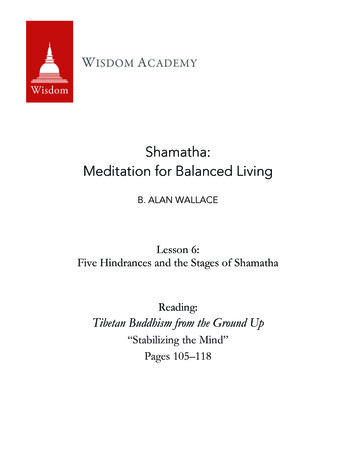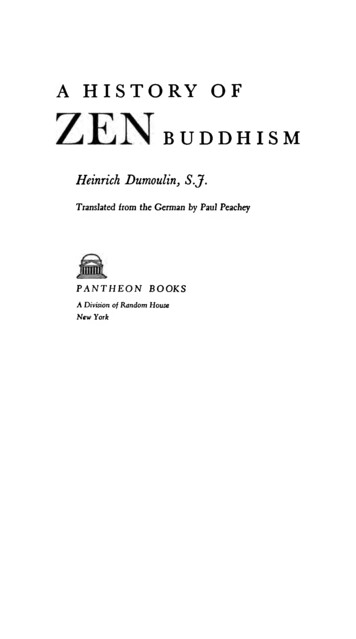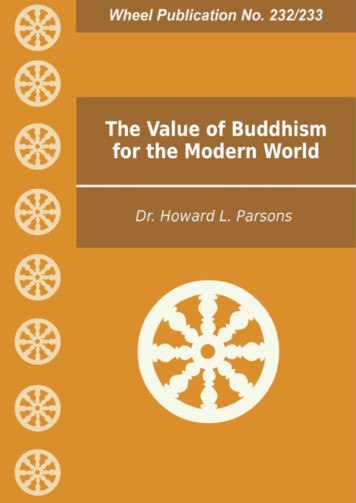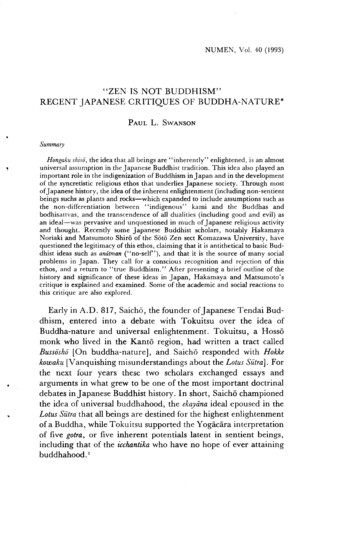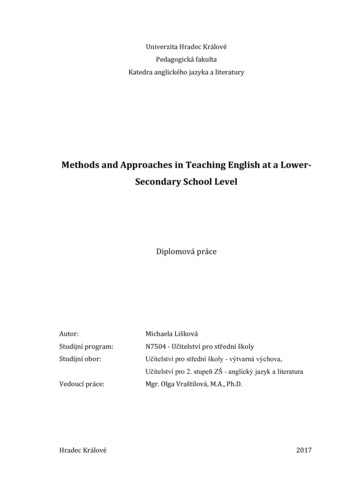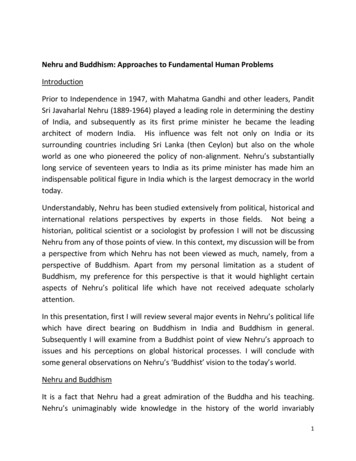
Transcription
Nehru and Buddhism: Approaches to Fundamental Human ProblemsIntroductionPrior to Independence in 1947, with Mahatma Gandhi and other leaders, PanditSri Javaharlal Nehru (1889-1964) played a leading role in determining the destinyof India, and subsequently as its first prime minister he became the leadingarchitect of modern India. His influence was felt not only on India or itssurrounding countries including Sri Lanka (then Ceylon) but also on the wholeworld as one who pioneered the policy of non-alignment. Nehru’s substantiallylong service of seventeen years to India as its prime minister has made him anindispensable political figure in India which is the largest democracy in the worldtoday.Understandably, Nehru has been studied extensively from political, historical andinternational relations perspectives by experts in those fields. Not being ahistorian, political scientist or a sociologist by profession I will not be discussingNehru from any of those points of view. In this context, my discussion will be froma perspective from which Nehru has not been viewed as much, namely, from aperspective of Buddhism. Apart from my personal limitation as a student ofBuddhism, my preference for this perspective is that it would highlight certainaspects of Nehru’s political life which have not received adequate scholarlyattention.In this presentation, first I will review several major events in Nehru’s political lifewhich have direct bearing on Buddhism in India and Buddhism in general.Subsequently I will examine from a Buddhist point of view Nehru’s approach toissues and his perceptions on global historical processes. I will conclude withsome general observations on Nehru’s ‘Buddhist’ vision to the today’s world.Nehru and BuddhismIt is a fact that Nehru had a great admiration of the Buddha and his teaching.Nehru’s unimaginably wide knowledge in the history of the world invariably1
included knowledge in this great world religion which was the mostnoteworthyIndian contribution to the human civilization. In his writings Nehruoften referred with admiration to the Buddha, his teachings and the rich culturalheritage of Buddhism. What he liked is not any particular tradition of Buddhism,but the teaching of the Buddha per se. He in fact did not like the cultural andritualistic thicket grown around it. Writing to his daughter from prison Nehru says:Buddha has always had a great appeal for me. It is difficult for me toanalyse this appeal, but it is not a religious, and I am not interested in thedogmas that have grown up round Buddhism. It is the personality that hasdrawn me.In 1931 (April-May) Nehru was in Sri Lanka for a month on a personal visit with hisfamily. In his autobiography later he reminisced of it:At Anuradhapura, I like greatly an old seated statue of the Buddha. A yearlater, when I was in Dehra Dun Goal, a friend in Ceylon, sent me a picture ofthis statue, and I kept it on my little table in my cell. It became a preciouscompanion for me, and the strong, calm features of Buddha’s statuesoothed me and gave me strength and helped me to overcome many aperiod of depression. (Gopalkrishna Gandhi, 2002, pp.5-6)Writing to Indira Gandhi ( July 3, 1939) Nehru again mentioned this statue: I hope to steal a day for Kandy and a few hours from Anuradhapurawhere I want to see again the old statue of the seated Buddha incontemplation. For the last seven years I had a picture of this almost alwayswith me, in prison or outside (Gopalkrishna Gandhi, 2002, p.15).Nehru liked the Buddha as a religious teacher who had a deep concern for humansuffering. He summarized the life of the Buddha in the following words:Why should there be so much folly and misery in the world? That is the oldquestion that troubled Prince Siddhartha 2500 years ago in this country ofours. (Nehru 2004 p.552)2
Also Nehru thought very highly of Asoka, his personal transformation and hispolitical philosophy both influence by Buddhism (Nehru 2004 pp.74-76).Nehru and Buddhism in the more recent Indian historyEmerging from vast devastations of hundred thousands of people, predominantlyHindus and Muslims including Sikhs, it is understandable why Nehru wished tocreate a secular state in independent India. Nehru’s secularism did not mean thathe kept aside religion altogether. It may be defined more in line with respect forall religions without preference for any particular religion. In this stance, Nehruhad a historical precedence from his own country, namely, Asoka, who famouslysaid (in his12th edict):King Devanampriya Priyadarsi honours all the religious persuasions andtheir clergy and their laity. The religious persuasion of others should berespected in every way. So doing, one promotes one’s own religion andsupports the other’s religion. Whoever extols one’s religion and disparagesanother’s religion entirely through devotion to one’s religion, thinking, ”weadd luster to our own religion”, injures one’s own religion very severely bydoing so. Let all listen to and be willing to listen to one another’s Dharma(Ananda W. P. Guruge, 1993, pp.564-5).Though being a Buddhist, Asoka admired and respected all the religions andtreated well all religious people belonging to various traditions. Asoka embodiedthe ideal of universal monarch (raja cakkavatti) who ruled the world by Dharmaand who conquered the world by Dharma (dharma vijaya). The Dharma headvocated for his people was common to all religious persuasions, and notexclusively Buddhist. Nehru had this example of pluralism, universalism andtolerance before him. It is most likely that he emulated Asoka in articulating hissecularist religious policy at the inception of independent India. It is in thiscontext that we have to understand the adoption of Asoka’s state symbol of lionsand the Dharma cakra as the symbol of the newly independent nation. In thisconnection, we cannot afford to forget the role of Bhim Rao Ambedkar (18911956), a renowned economist and the leader of Dalits, who was the first ministerof justice and law in the first parliament and chairman of constitution drafting3
committee. Ambedkar who accepted Buddhism with about six hundred thousandsof his followers in 1956, was already a great admirer of the egalitarian teachingsof the Buddha and his universalist social philosophy. The Buddhist concept of‘pancashila’ found a place in the constitution although with a differentcontent.Once the constitution came out it was praised as a “social document” forthe fact that it incorporated a system of ‘affirmative action’ which ensured socialand economic justice for the scheduled castes and women. It is clear thatphilosophies of both Ambedkar and Nehru coincided and thus was born the greatconstitution of modern India.2500 Buddha JayantiThe 2500th anniversary of the Buddha’s parinirvana, which was given the eversince popular name ‘Buddha Jayanti’, was a key occasion in which Nehru’sadmiration of Buddhism became clear to the world. The idea of celebrating thisoccasion was initiated by Lanka Bauddha Bala Mandalaya in 1950 under theguidance of the late Professor G.P. Malalasekera, its founder chairperson. Nehru’sgovernment took this occasion very seriously. He appointed a high-poweredcommittee with Sarvapalli Radhakrishnan, the Vice President, as its chairperson,to organize the celebrations in India. In addition to issuing commemorativestamps, holding numerous exhibitions and the like, the committee organizedseveral major projects:(1) A 40 volume publication of Tripitaka in Pali and Sanskrit.(2) Editing and publishing Buddhist Sanskrit works.(3) A volume of academic papers covering the entire history of Buddhism inthe world. 2500 Years of Buddhism, edited by the late professor P.V. Bapathand published by the Indian government was the result of this.(4) Publication of a pictorial book portraying the history and spread ofBuddhism in the world. The Way of the Buddha was the result of it. (AsiaTribune, accessed on 20.11.2015).4
The main celebration was held at Buddhagaya under the leadership of Nehru. In1957 Nehru was invited to Sri Lanka to mark the completion of the Buddha Jayanticelebrations here. This personal involvement of Nehru and his willingness tospend public funds in the historic event shows how he perceived Buddhism not asa mere religion among many religions but as a great cultural force to provide lightto the world.Dalai Lama and the Arrival of Tibetan Buddhism in IndiaThis politically sensitive event took place in the 30th March 1959 when Dalai Lamaalong with a group of his followers crossed the Tibetan border to India. AlthoughNehru knew that this could create difficulties to his non-interventionist positionagreed upon with China in the joint treaty between the two countries in 1954 hedecided to grant asylum to the spiritual leader and his group. This was followedby the arrival of several hundred thousands of Tibetan Buddhist in India finallyestablishing their headquarters in Dharmasala. Nehru’s stance on Tibet and hissupport for the Tibetan religious leader and his people had political repercussions.Nevertheless, Nehru stood by Tibetan Buddhists and gave massive support forthem to reestablish their great monastic centres in different parts of India and toestablish higher education centres to preserve and promote their culture andtradition.Decisions made by people are taken as either vindicated or refuted by the eventsthat follow subsequently. Accordingly makers of those decisions are eitherblamed or praised. It is more so with political decisions. But I think that a decisionshould be weighed primarily on whether or not it was the right decision to makeat that given point of time, given the circumstances.In the ensuing history onlysome decisions are lucky and some are not. In accepting Dalai Lama and hispeople to India and subsequently supporting them in a substantial manner, it isclear that Nehru had made a mammoth decision, which did not make subsequentIndia-China relations particularly endearing but made India lovable to TibetanBuddhists and lovers of Tibetan Buddhism all over the world. Although ‘Tibetanquestion’ still remains unresolved, after a little more than five decades, Tibetan5
Buddhism has become the most wide spread form of Buddhism in India as well asin the outside world.Nehru’s approaches to issuesIn dealing with Tibetans as he did, Nehru was thinking in terms of a problemsfaced by human beings. Although this may sound a simple truism, when problemsare viewed through such terms as national and inter-national, they tend toassume huge dimensions and lose the immediacy as human problems. Indiscussing the estate Tamil problem which was a contentious issue between Indiaand Sri Lanka in the middle decades of the last century Nehru said (in his speechto LokSabha on April 9, 1958):Fortunately, in spite of the complicated and difficult nature of the problem,it is increasingly realized in Ceylon by the Government and others and by usthat it should not be treated as a political issue or dispute, but as a humanproblem. I do hope that, however long it may take, it will be settled in afriendly way and to the advantage of the large number of human beingswhose welfare is involved.(Gopalkrishna Gandhi, 2002, p.81).Although I do not venture to say that Nehru got this ‘human orientation’ fromBuddhism, certainly two approaches coincide. The Buddha saw problems asbasically human problems whether they originate directly from them or not. TheBuddha articulated this insight when he said: I say that suffering, its arising, itscessation and the path leading to its cessation, all found within this fathom-longbody with perception and mind.Let me cite from his speech at University of Ceylon convocation address (January12, 1050) an instance when Nehru articulated, with reference to vasttechnological innovations and knowledge acquisition, his vision of humanpredicament.Referring obviously to globalization, which was not identified by that term duringthe middle of the last century, Nehru says:6
Now, one of the brighter features of this age is – and I attach a great deal ofvalue to it – that the barriers that separated the so-called East from the socalled West are gradually disappearing. That is a good sign. But, at the sametime, other barriers seem to be growing in the East and in the West.(Gopalakrishnan Gandhi, 2002 p.36)Globalization is basically the reduction of gaps of time and space as aconsequence of which we reach today longer distances within shorter periods oftime. Technological innovations in transport and communication have madehuman beings much closer to one another as have never been before. Underthese conditions, with vast knowledge of different cultures and societies, onewould expect a world not only physically close to one another but alsoemotionally close.One would expect mutual knowledge to lead to mutualunderstanding. But we know that this has not happened. The world issubstantially different today from the world of early 1950s when Nehru deliveredhis convocation speech. We know much more today about all aspects of realitythan those in Nehru’s time did. But the paradox is that this knowledge, ratherthan integrating, has disintegrated us from one another.Nehru analyses this situationas resulting from the growth of knowledge in thefollowing words:We have advanced greatly in science – I am a great believer in science –and the scientific approach has changed the world completely. I think thatif the world is to solve its problems it will inevitably have to be through themeans of science and not by discarding science. Nevertheless, I find thatthe sheer advance of science has made people, often enough, not scientific,which is an extraordinary thing to say. What I mean is that science hasbecome so vast and all-pervading that scientists are unable to grasp thething entire and become narrower and narrower in each individual subject.They may be very brilliant in some subjects but they seem to lose grip onlife as a whole. (Gopalakrishna Gandhi 2002 p.37).Continuing this vein of thought, Nehru refers to times when people knew less buthad ‘an integrated view of life’ which made them wise. Nehru, ardent believer of7
science and growth of knowledge, appears here contradicting himself in referringto the past when people knew less and felt much. I do not think Nehru wascontradicting himself when he talked about wisdom as higher than knowledge.Accumulation of knowledge in itself may not be good or bad. The crucial questionto be raised, according to a Buddhist way of thinking, is: knowledge for whatpurpose? According to Buddhism, knowledge is not for the sake of knowledge; itis gained always for action, and action should always be guided by compassionand wisdom, two pillars of Buddhist social action. Knowledge and action withoutmoral guidance will ultimately serve the purpose of inflating one’s own ego to theexclusion of the rest and perceiving oneself as an end in itself.Liberal individualism with its associated goal, freedom, has become the onlyrationality of today. Aristotlean two –valued logic has given us the option ofeither/or, and the principle of excluded-middle has taken away any third optionfrom us. Consequently the world has been bifurcated into clear-cut divisions ofwhich one is necessarily true when the other is false.The Indian tradition, long before, had gone beyond this limited way of thinking,and that it is so is testified by Sanjaya’s (one of the six religious teachers duringthe time of the Buddha) skepticism, Jaina Mahavira’s seven-fold predication(sapta-bhangi) which says ‘may be’ (syad) in the place of ‘is’, and the Buddha’s,and following him, Nagarjuna’s four cornered proposition (catuskoti), not tomention Taoist yin-yang (passive and active principles of the universe). All ofthese lead us to be wary of our false certainties and be aware of our ownimperfections and limitations.Nehru knew about his own imperfections. In this very same convocation speechunder discussion he says:In the citation about me I was referred to as a person who had, I believe,profound wisdom and political astuteness. I do not know how far I ampolitically astute but I must confess to you that the older I grow the moreand more do I feel the lack of wisdom in myself. Perhaps it may be that thevery feeling is a sign of having some wisdom. (Gopalakrishnan Gandhi,2002, p.35)8
I am reminded of the Buddha’s statement (in the Dhammapada 63) that a foolwho knows about his foolishness is in fact wise. Nevertheless, his politicalbiography has ample evidence to show that Nehru was much wiser than in thisminimal sense.The secularist position adopted by Nehru at the very outset of independent Indiawas both challenging and enlightening. He had the courage to go for what heconsidered to be the right view at that moment of national destiny. Identitiesrooted in ethnicities and religiosities have continued to function as greatmotivating forces all over the world, not only in India. The Buddha saw thissituation in his times and described it as ‘wilderness of ideologies and desert ofideologies.’ He guided his listeners to transcend these man-made boundaries.Asoka following the example of the Buddha said that all human beings are hischildren (save manusa mama paja), and put this universalist philosophy intopractice. I see Nehru’s secularist position as following these historical examples.Looking at some of the exciting and interesting exchange of views and debateshappening at this very moment in India It is clear that the Buddha, Asoka andNehru are as relevant today as they were in their times.The conclusion of my presentation is not that Nehru was the wisest of all primeministers of India. Nehru has both his admirers and detractors. But undoubtedlyhe was a thinker in his own right, a quality not always associated with politics.Discussing Nehru, S.W.R.D. Bandaranaike said that “ Nehru is one of the fewstatesmen of the world who have a background of culture and learning, and whoare thinkers beside being also men of action” (Gopalakrishna Gandhi, 2002 p. x). Itis perhaps this combination of virtues of culture, learning and thinking that Platohad in mind when he said (in the Republic) that rulers have to be philosophers.Nehru, I believe, was one of the closest examples of our times to this Platonicideal.9
ReferenceBrown, Judith M. (2003) Nehru: A Political Life (New Delhi: Oxford UniversityPress).Guruge, Ananda W.P. (1993) Asoka: A Definitive Biography (Colombo: Ministry ofCultural Affairs and Information, Government of Sri Lanka).Gandhi, Gopikrishna (2002) Nehru and Sri Lanka: A collection of JawaharlalNehru’s speeches and writings covering three decades (Ratmalana, Sri Lanka:SarvodayaVishvalekha Publications).Moraes, Frank (Second Jaico impression 2008) Jawaharlal Nehru: A Biography(Mumbai: Jaico Publishing House).Nehru, Jawaharlal (2004) Glimpses of World History (London: Penguin Books).10
It is clear that . a mere religion among many religions but as a great cultural force to provide light to the world. Dalai Lama and the Arrival of Tibetan Buddhism in India This politically sensitiv

